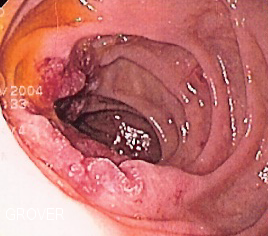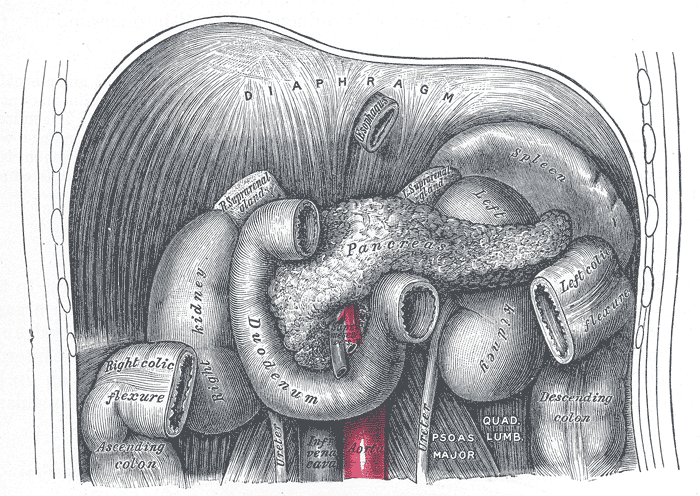Small intestine cancer
For patient information click here
Editor-In-Chief: C. Michael Gibson, M.S., M.D. [1]
|
Small intestine cancer Microchapters |
|
Diagnosis |
|---|
|
Treatment |
|
Case Studies |
|
Small intestine cancer On the Web |
|
American Roentgen Ray Society Images of Small intestine cancer |
|
Risk calculators and risk factors for Small intestine cancer |
Overview
Pathophysiology
Epidemiology & Demographics
Risk Factors
Natural history, Complications, and Prognosis
Classification
Causes of Small cell carcinoma
Differentiating Small cell carcinoma from other Diseases
Diagnosis
History & Symptoms
Lab Tests
MRI
CT
Echocardiography or Ultrasound
Other Imaging Findings
Other Diagnostic Studies
Treatment
Dietary Management
Medical Therapy
Surgery
Primary Prevention
Overview

In oncology, small intestine cancer, also small bowel cancer and cancer of the small bowel, is a cancer of the small intestine. It is relatively rare compared to other gastrointestinal malignancies such as gastric cancer (stomach cancer) and colorectal cancer.[1]
Small intestine cancer can be subdivided into duodenal cancer (the first part of the small intestine) and cancer of the jejunum and ileum (the later two parts of the small intestine).
Several different subtypes of small intestine cancer exist. These include:
Duodenal cancer


Duodenal cancer is a cancer in the beginning section of the small intestine. It is relatively rare compared to gastric cancer and colorectal cancer. Its histology is usually adenocarcinoma. Familial adenomatous polyposis (FAP) is a risk factor for developing this cancer.
The duodenum is the first part of the small intestine. It is located between the stomach and the jejunum. After foods combine with stomach acid, they descend into the duodenum where they mix with bile from the gall bladder and digestive juices from the pancreas.
Duodenal cancer is difficult to remove surgically because of the area that it resides in, there are many blood vessels supplying the lower body. Chemotherapy is sometimes used to try and shrink the canceous mass. Other times intestinal bypass surgery is tried to reroute the stomache to intestine connection around the blockage. A 'Whipple' is a possible surgery that is tried sometimes with this cancer.
The cancerous mass tends to block food from getting to the small intestine. If food can not get to the intestines, it will cause pain, acid reflux, and weight loss because the food can not get to where it is supposed to be processed and absorbed by the body.
Some patients are fitted with tubes to either add nutrients (feeding tubes) or drainage tubes to remove excess processed food that can not pass the blockage.
Patients with duodenal cancer may experience abdominal pain, weight loss, nausea, vomiting, and chronic GI bleeding.
Risk Factors
Risk factors for small intestine cancer include[2][3]:
- Crohn's disease
- Celiac disease
- Radiation exposure
- Hereditary GI cancer syndromes: familial adenomatous polyposis, hereditary nonpolyposis colorectal cancer, Peutz-Jeghers syndrome
- Male
Benign tumours and conditions that may be mistaken for cancer of the small bowel:
References
- ↑ Terry SM, Santora T. Benign Neoplasm of the Small Intestine. eMedicine.com. URL: http://www.emedicine.com/med/topic2652.htm. Accessed on: June 2, 2006.
- ↑ Delaunoit T, Neczyporenko F, Limburg PJ, Erlichman C. Pathogenesis and risk factors of small bowel adenocarcinoma: a colorectal cancer sibling? Am J Gastroenterol. 2005 Mar;100(3):703-10. PMID 15743371.
- ↑ Chen AC, Neugut AI. Malignant Neoplasms of the Small Intestine. eMedicine.com. URL: http://www.emedicine.com/MED/topic2651.htm. Accessed on: June 2, 2006.
External links
- Malignancies of the Small Bowel - emedicine.com.
- Rare Cancer Support Group Forum - survivor-support.rare-cancer.org.
- Yahoo Duodenal Cancer Support Group